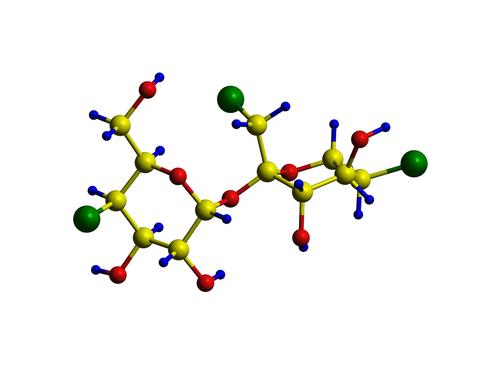A recent article, published in the journal Toxicological and Environmental Chemistry reported that when people eat the non-nutritive sweetener sucralose (the sweetening ingredient in Splenda®) some of it is absorbed into the blood and then excreted by the kidneys in urine. Such a report is ripe for the scare-mongers, especially since the report found that the level of sucralose in the blood is higher in children than in adults. But is this something to be worried about? Unlikely.
Sucralose is a derivative of the common sugar sucrose which has been modified by replacement of 3 hydroxyl (OH) groups with of 3 chlorine atoms (the green balls in the illustration above). It has been described as anywhere from 300 to 1,000 times sweeter than sucrose (the range likely reflects the medium in which it was tested), and thus only very tiny amounts need be used for an equivalent sweetness. For more on sucralose and other sweeteners see ACSH's publication Sugar Subsitutes and Your Health.
In the study mentioned above, Dr. Allison C. Sylvetsky from the National Institutes of Health in Bethesda, MD and colleagues measured the blood levels of sucralose after consumption of various doses of sucralose in water, diet cola, or seltzer. The doses were equivalent to the amounts of sucralose in 1-4 diet sodas.The study participants included 22 adults and 11 children — about 9 years old (the children consumed only 1 dose — 68 mg). Blood samples were taken before ingestion, and at intervals for 2 hours post-ingestion in an oral glucose tolerance test.
They found that the concentrations in the adults' blood were similar no matter which liquid was used — seltzer, water, or cola. Because of their smaller size and smaller blood volume, the children's blood concentrations of sucralose were significantly higher than those of the adults. So should we be worried? Let's take a look at some numbers.
An earlier study, published in Food and Chemical Toxicology examined the actual absorption of sucralose from the gastrointestinal tract of 8 volunteers, and its excretion rate thereafter. These investigators found that within 5 days of consuming 1 mg of sucralose per kgm body weight, nearly 15 percent of the dose was excreted in the urine (meaning it had been absorbed into the blood), while about 78 percent was excreted in the feces (that is, it passed through the GI tract without being absorbed). Note that the FDA lists an acceptable daily intake of sucralose as 5 mg/kg body weight per day, so that a person weighing about 130 pounds (60 kg) would have to consume 23 packets of sucralose per day to achieve that level of intake.
So on the basis of these studies, a 60 kgm person eating 23 packets of sucralose would eat 5 mg/kgm X 60 kgm or 300 mgm. Then, about 15 percent or 45 mg would be absorbed — way below the ADI — assuming the same percentages would hold as in the second study. A diet soda contains about 70 mg of sucralose — 15 percent of that amount would be about 11 mg absorbed.
In terms of consumption, the adults in the more recent study would have consumed from 0.66 to 4.8 mg/kg, depending on dose administered and body weight. The children, who were given only a 68 mg dose, consumed between 1.3 to 2.8 mg/kg, depending on body weight.
It's important to understand that the sucralose safety profile has been tested and approved by the FDA, and to view these results in that context. The concern about higher sucralose concentrations in children is likely to be because early experiences may influence later taste preferences for sweet-tasting foods and liquids. Whether or not these results are widely applicable (only 11 children were tested) remains to be determined. In the meantime, the best advice remains — everything in moderation.




